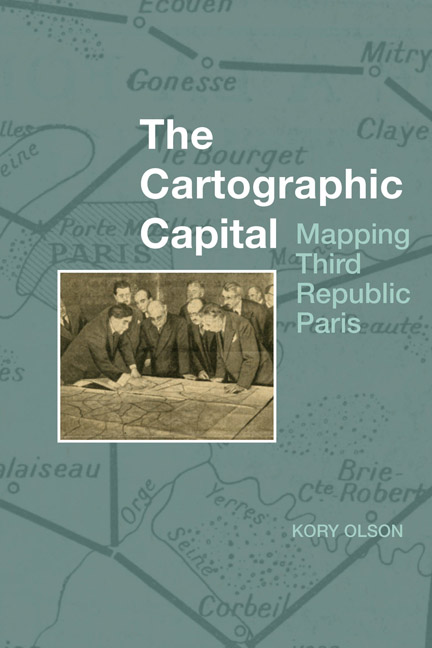Book contents
- Frontmatter
- Contents
- List of Figures
- Acknowledgements
- Introduction: Creating Republican Paris
- 1 Working with Maps
- 2 Creating Map Readers: The Rise of Geography and Cartography in Nineteenth-Century France
- 3 The Triumphant Republic: ‘Paris en 1889, les opérations de voirie exécutées entre 1871 et 1889’
- 4 A New Way of Seeing Paris: The Service Géographique's Carte de France
- 5 The Beginning of French Urbanism: Léon Jaussely's 1919 Plan d'extension
- 6 The Rise of Suburban Paris: Henri Prost's Carte générale
- Conclusion
- Bibliography
- Index
4 - A New Way of Seeing Paris: The Service Géographique's Carte de France
- Frontmatter
- Contents
- List of Figures
- Acknowledgements
- Introduction: Creating Republican Paris
- 1 Working with Maps
- 2 Creating Map Readers: The Rise of Geography and Cartography in Nineteenth-Century France
- 3 The Triumphant Republic: ‘Paris en 1889, les opérations de voirie exécutées entre 1871 et 1889’
- 4 A New Way of Seeing Paris: The Service Géographique's Carte de France
- 5 The Beginning of French Urbanism: Léon Jaussely's 1919 Plan d'extension
- 6 The Rise of Suburban Paris: Henri Prost's Carte générale
- Conclusion
- Bibliography
- Index
Summary
Des pensées de découragement lui venaient; mais André était persévérant: au lieu de se laisser accabler par les difficultés qui se présentaient, il ne songea qu’à les combattre. Tout à coup il se souvint d'avoir vu dans la chambre du garde forestier une grande carte du département, pendue à la muraille: c’était une de ces belles cartes dessinées par l’état-major de l'armée française, et où se trouvent indiqués jusqu'aux plus petits chemins.
—Fouillée, Le Tour de la France par deux enfants (1905)In the Third Republic history and geography text Le Tour de la France par deux enfants, famous child adventurers André and Julien hope to cross into France from their native Lorraine in search of their lost uncle, an adult who could help them obtain their French citizenship after the annexation to Germany. As the two orphans prepare to traverse the new border, their guide is injured and the boys worry about how they will proceed. At the last minute André, the ingenious older brother, turns to a wall-mounted Carte d’état-major, an official army map in order to navigate across the border.
It is ironic that the French army, so cartographically deficient and easily defeated in 1870 by the same Prussians the youths wish to flee, now provides their eventual means of escape. The self-proclaimed ‘meilleur élève’ in German-occupied Phalsbourg eagerly employs his map-reading skills to traverse unfamiliar territory and enter ‘la France glorieuse.’ The geography inside post-1884 Le Tour de la France par deux enfants suggests that leaders recognized its cartographic deficit and wished to rectify this shortfall at a time when soul-searching and sober examination of France's recent military defeat called for a change in how they understood and portrayed the nation. The expanding use of maps in the French educational system played a pivotal role in helping the Third Republic get to know its territory better and allowed its citizens to understand the maps they saw in the real world. The ability to identify and view a territory mentally became more widespread in the general population, epitomized here by André and Julien's use of the departmental Carte d’état major to find their way into France from German-controlled Lorraine.
- Type
- Chapter
- Information
- The Cartographic CapitalMapping Third Republic Paris, 1889-1934, pp. 130 - 174Publisher: Liverpool University PressPrint publication year: 2018



